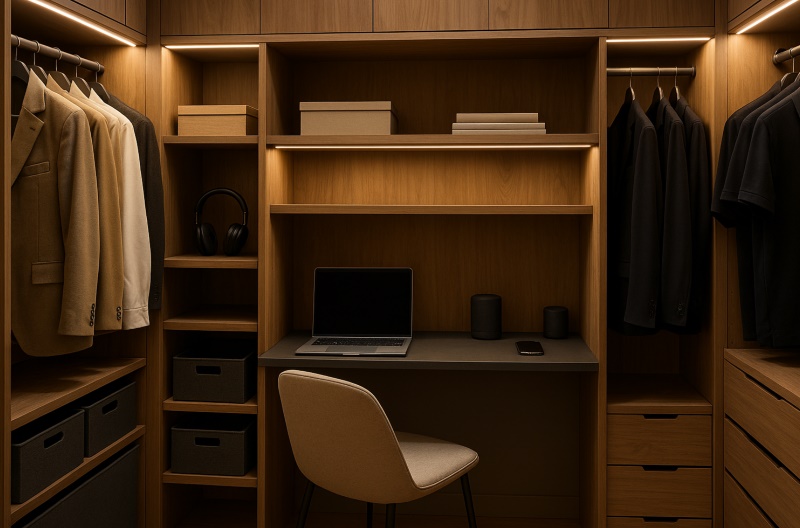The bedroom closets are no longer just a storage pit for winter coats and mismatched shoes. It’s transforming — quietly but unmistakably — into something smarter, sharper, and surprisingly essential. As our homes continue to double as our offices, classrooms, and studios, the boundaries of where we work, think, and recharge have shifted. And in this redefinition of space, bedroom closets are stepping up in unexpected ways.
They’ve always been private by nature — closed off, tucked away, easy to ignore. But today, their function is being reimagined as something far more dynamic. No longer limited to hanging clothes and stacking boxes, closets are evolving into controlled environments that support daily rhythm and mental clarity. They’re becoming the backdrop of focus and preparation — zones where order and intention meet.
In many modern households, bedroom closets are now integrated with specific utilities that serve beyond wardrobe needs. Think custom pull-out shelves for storing headphones and portable hard drives, drawers with built-in charging docks for phones and tablets, or upper compartments dedicated to document filing. These compact upgrades have turned closets into self-contained stations for productivity, enabling people to prep not just for their day — but for their goals.
Designers have taken note. The new generation of bedroom closets is built to adapt. Custom carpentry now includes built-in lighting that mimics daylight for improved visibility during early hours or late nights. Some layouts feature motion-triggered LED strips, soft-close panels, and sliding organizers that make quick access feel intuitive and calm. It’s not about extravagance. It’s about control — of one’s time, mood, and habits.
The shift isn’t just functional; it’s deeply psychological. There’s a reason productivity experts emphasize reducing visual clutter and creating designated zones for specific activities. A well-organized closet becomes a kind of launchpad, a mental cue that the day has started — or ended. When everything has its place, decision fatigue drops. Time gets reclaimed. Energy flows better. And all this starts behind a closet door.
Even smart home technology has found its way into this space. Motion sensors that sync with morning alarms can trigger closet lighting. Voice commands can pull up music or to-do lists via a built-in speaker shelf. Some homeowners are even embedding air purifiers into walk-in units to keep garments fresh while improving air quality in sleeping areas. What was once dead space is now a living system.
In this evolution, form still matters. Today’s bedroom closets are expected to be both purposeful and polished. Clean lines, smart dividers, adjustable rods, and modular compartments offer an efficient footprint without sacrificing visual comfort. It’s no coincidence that many of these features are finding their way into curated storage solutions from experienced creators. For those seeking thoughtful design and smart functionality, platforms like alliancemillwork.ca offer customized answers that reflect how modern people really live and work.
But the conversation goes beyond furniture. It touches on wellness, autonomy, and the simple act of getting ready in a space that feels intentional. When a closet holds not just what you wear but what you need to think clearly, it starts to carry more weight in the architecture of a productive life.
Some use these new closet setups as prep zones for early workouts — shelves with yoga mats, foam rollers, or hydration packs neatly stacked and waiting. Others turn a section into a dedicated accessories hub — charging docks for wearables, drawers for work ID badges, even compact safes for sensitive materials like backup drives or documents.
There’s a growing appeal to having a zone that’s off-grid but fully operational. Away from the kitchen clatter, the glowing laptop, and the noise of shared spaces, bedroom closets offer a small corner of personal infrastructure. They’re out of view but not out of function. Their quiet presence supports the rhythm of the day in subtle ways, offering both preparation and closure.
In homes where square footage is tight, this matters even more. The closet becomes a transformer — part personal archive, part digital command post. It’s a place where clothes meet cables, where jackets hang beside work bags that double as mobile offices. The more carefully this space is built, the more it repays with time saved and effort reduced.
What’s emerging is a new standard: storage that doesn’t just hold things but helps drive things forward. Spaces that aren’t simply functional, but intentional. Bedroom closets — once overlooked — are now central to the conversation around how design supports daily life. They’re reminders that productivity doesn’t always start with a desk. Sometimes, it starts with a drawer that opens just right, a pair of headphones in their place, and a feeling that everything you need is exactly where it should be.
And that might be the quietest productivity hack of them all. Therefore, bedroom closets are the best new productivity trend at homes.
Read More: Make Your Windows Look Elegant with Blinds







